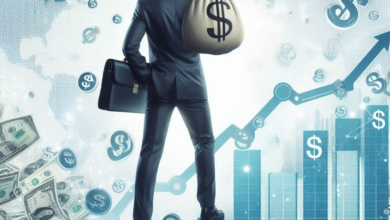
In the world of finance, few crimes capture the public imagination like insider trading. We picture secret meetings in parking garages, briefcases full of cash, and whispered stock tips that lead to instant fortunes. While the Hollywood version is dramatic, the reality of how this white-collar crime is caught and prosecuted is a fascinating, high-tech detective story—a world of digital breadcrumbs, sophisticated data analysis, and old-fashioned investigative grit.
But how do regulators sitting in an office possibly catch a single illegal trade among the billions of transactions that happen every day? It’s not magic; it’s a powerful combination of technology, whistleblowers, and the painstaking work of connecting the dots.
This guide will pull back the curtain on this shadowy corner of the financial world. We will explore what insider trading truly is, how the digital watchdogs first spot suspicious activity, and the step-by-step playbook investigators at the Securities and Exchange Commission (SEC) use to build a case that can end with massive fines and prison sentences.
What Exactly Is Insider Trading? It’s About Unfair Advantage

Before we dive into the investigation, it’s crucial to understand the crime itself. At its core, insider trading is not just about trading; it’s about trading with a massive, unfair advantage. The law defines it as the buying or selling of a security in breach of a fiduciary duty or other relationship of trust and confidence, while in possession of material, non-public information (MNPI).
Let’s break down that legal jargon:
- Material Information: This is any information that a reasonable investor would likely consider important in making a decision to buy, sell, or hold a stock. If the news would move the stock’s price, it’s material. Examples include:
- An upcoming merger or acquisition.
- A blockbuster earnings report that will surprise the market.
- Positive or negative results from a crucial clinical trial for a drug company.
- The planned departure of a key executive.
- A major new product launch or a significant cybersecurity breach.
- Non-Public Information: This is the key. The information has not been released to the general public. As long as it remains confidential, trading on it is illegal.
- Breach of Duty: The person trading on the information, or the person who leaked it, must have had a duty to keep it confidential. This includes company executives, board members, lawyers, accountants, and investment bankers. But it also extends to anyone they share the information with—a concept we’ll explore later.
Insider trading isn’t a victimless crime. It fundamentally undermines the integrity of the market by suggesting the game is rigged. If the public believes that insiders are the only ones who can win, they will lose trust and stop investing, which is disastrous for the entire economy.
The Digital Watchdogs: How Are Suspicious Trades First Detected?
The hunt for an illegal trade rarely begins with a detective knocking on doors. Today, the first line of defense is a powerful and sophisticated network of technological surveillance systems designed to spot anomalies in the market’s data stream.
Sophisticated Market Surveillance
The primary watchdog is the Financial Industry Regulatory Authority (FINRA), a self-regulatory organization that monitors all trading on U.S. exchanges. FINRA uses a cutting-edge surveillance system known internally as SONAR (Securities Observation, News Analysis, and Regulation).
This system is a technological marvel. It ingests and analyzes up to 135 billion market events every single day—every trade, every quote, every cancellation. SONAR’s algorithms are programmed to look for suspicious trading patterns that precede significant, price-moving news.
Here’s what it looks for:
- Impeccably Timed Trades: Did a person who has never traded a particular pharmaceutical stock before suddenly buy a huge number of call options just days before the company announced a successful drug trial?
- Trading in Related Companies: Did someone buy a large stake in a small, unknown company right before a corporate giant like Google or Amazon announced they were acquiring it?
- Geographic and Social Connections: The system can cross-reference trading data with a vast database of social and professional relationships. It can flag trades made by the college roommate of a company’s CFO, or by a group of people who all live in the same small town where a company has its headquarters.
When SONAR flags a pattern as highly suspicious, it generates an alert. Human analysts at FINRA then review the alert, conduct preliminary research, and if they believe there’s a strong case, they refer it to the SEC’s Division of Enforcement.
Tips, Complaints, and Whistleblowers
While technology is the dragnet, a significant number of investigations begin the old-fashioned way: with a tip. The SEC receives tens of thousands of tips, complaints, and referrals every year from a variety of sources:
- Market Professionals: Honest brokers or traders who notice suspicious activity by a client.
- The Public: An investor who believes they’ve been wronged or has observed strange market behavior.
- Whistleblowers: This is a huge source. Under the Dodd-Frank Act, the SEC has a powerful whistleblower program that allows individuals with inside knowledge of securities fraud to report it. If the information leads to a successful enforcement action with sanctions over $1 million, the whistleblower can receive between 10% and 30% of the money collected. This financial incentive has opened a floodgate of high-quality tips from corporate insiders.
Connecting the Trader to the Tip: The Investigator’s Playbook

Once the SEC has a credible lead, the real detective work begins. A suspicious trade by itself is not a crime. The entire case rests on the investigator’s ability to prove one critical thing: that the person who made the trade was in possession of material, non-public information when they did it.
This requires building a chain of evidence that connects the trader to the source of the inside information. To do this, SEC investigators have a powerful legal toolkit:
- Subpoenas for Trading Records: This is the first step. They get the complete trading history of the suspect and any connected individuals.
- Subpoenas for Communications: This is where many cases are made or broken. The SEC will demand phone records, emails, text messages, and even messages from encrypted apps. They are looking for any communication between the trader and a potential inside source around the time of the suspicious trade.
- Bank Records and Financial Tracing: Investigators follow the money. Did the trader receive a large, unexplained payment before the trade? Did they pay someone after the trade was profitable?
- Interviews and Testimony: SEC attorneys will take sworn testimony (similar to a deposition) from everyone involved—the trader, their broker, the corporate insiders, and anyone in between. Lying under oath to the SEC is a federal crime in itself.
Unraveling the “Tipper-Tippee” Chain
Many insider trading cases are not straightforward. They involve a chain of information, known as “tipper-tippee” liability.
- The Tipper: This is the corporate insider who has the confidential information and a duty to protect it. They breach that duty by “tipping” the information to someone else, usually for some kind of personal benefit (which can be financial, reputational, or even just the good feeling of giving a gift to a friend or relative).
- The Tippee: This is the person who receives the tip and knows (or should have known) that the information was confidential and that the tipper was breaching their duty. The tippee is just as liable as the tipper when they trade on that information.
Investigators will painstakingly work their way up this chain, often starting with the trader (the tippee) and pressuring them to reveal their source (the tipper).
From Wall Street to the Courtroom: Real-Life Case Studies
The best way to understand the process is to look at real cases.
- The Martha Stewart Case: This is a classic example of how the investigation itself can be as damning as the crime. Stewart sold shares in a biotech company, ImClone, right before negative news about its lead drug was made public. The investigation revealed that her broker had told her that the ImClone CEO was trying to sell his own shares. While proving the initial tip was difficult, Stewart’s subsequent actions—lying to federal investigators about the reason for her sale—led to her conviction for obstruction of justice.
- The Raj Rajaratnam Case (Galleon Group): This massive case in the late 2000s showed the scale of modern investigations. Rajaratnam, a hedge fund billionaire, was the center of a huge “expert network” of corporate insiders who would feed him illegal tips. The FBI and SEC built their case using wiretaps, informants, and extensive data analysis, ultimately leading to one of the longest prison sentences ever handed down for insider trading.
The Hammer of Justice: What Are the Penalties for Insider Trading?

If the SEC builds a successful case, the consequences are severe and can come from two directions.
- Civil Penalties (from the SEC):
- Disgorgement: The trader must pay back all of their illegal profits, plus interest.
- Civil Fines: The SEC can impose fines up to three times the amount of the profit gained or loss avoided.
- Officer and Director Bars: Individuals can be barred from ever serving as an officer or director of a public company.
- Criminal Charges (from the Department of Justice):
- For serious and willful violations, the SEC can refer the case to the Department of Justice (DOJ), which can file criminal charges.
- Prison Time: A conviction can lead to a federal prison sentence of up to 20 years.
- Criminal Fines: These can run into the millions of dollars for individuals and tens of millions for corporations.
Why Insider Trading Investigations Matter to You
The relentless pursuit of insider traders isn’t just about punishing a few greedy individuals. It’s about protecting the foundation of our entire financial system. For the average person investing for retirement in their 401(k) or IRA, these investigations are essential.
They ensure that the market is a level playing field, where success is determined by diligence, patience, and smart analysis—not by who you know. They maintain the public’s trust that the game isn’t rigged, encouraging the broad participation that fuels economic growth and allows millions of Americans to build a secure financial future.





